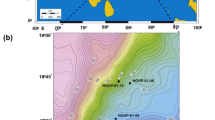Abstract
The leakage-type hydrate is filled in the fractures, with steep and directional dips characteristics and the reservoir is basically anisotropic. The fractures characteristics are the key factors for reserve estimation and making of the production plan, and it is also the challenge and difficulty of the seismic exploration. Here we use the existing data recorded from ocean-bottom seismometers in the northeastern slope of South China Sea to carry out the research on whether the hydrate reservoir has the seismic anisotropy characteristics, and the results show that the seismic anisotropy characteristics is very obvious. The thickness and position of HTI medium lies between the time of 1550 ms and 1600 ms. On the basis of HTI anisotropy, combined with the geological situation of the region, it is assumed that vertical fractures exist in the region and the leakage-type hydrate exists. Also the research on parameters extracted from the fracture strike is carried out. The symmetry axis and the fracture directions of fractures are estimated. The results show that 60° and 240° correspond to the fractures symmetry axis, and 150° and 300° are the fractures trend. The recognition is very important for the estimation of the gas hydrate’s saturation.






Similar content being viewed by others
References
Alford RM (2004) Sheardata in the presence of azimuthal anisotropy: Dilly, Texas. SEG Technical Program Expended Abstracts 2004. Society of Exploration Geophysicists, 183–186
Barclay AH, Toomey DR (2003) Shear wave splitting and crustal anisotropy at the Mid-Atlantic Ridge, 35°N. J Geophys Res 108(B8):2378
Crampin S (1987) Crack porosity and alignment from shear-wave VSPs, in shear-wave exploration. In: Danborn SH, Domenico SN (eds) Geophysical developments, SEG Special Publication, pp 227–251
Crampin S (1993) A review of the effects of crack geometry on wave propagation through aligned cracks. Can J Expl Geophys 29:3–17
Crampin S, Peacock S (2005) A review of shear-wave splitting in the compliant crack-critical anisotropic Earth. Wave Motion 41:311–330
Exley RJK, Westbrook GK, Haacke RR (2010) Detection of seismic anisotropy using ocean bottom seismometers: a case study from the northern headwall of the Storegga Slide. Geophys J Int 183:188–210
Fan S, Liu F, Chen D (2004) The research of the origin mechanism of marine gas hydrate. Natural Gas Geo Sci 15(5):524–529
Lee MW, Collett TS (2009) Gas hydrate saturations estimated from fractured reservoir at Site NGHP-01-10, Krishna-Godavari Basin, India. J Geophys Res 114(B07102):0148–0227
Liang J, Fu S, Chen F, Su P, Shang J, Lu H, Fang Y (2017) Characteristics of methane seepage and gas hydrate reservoir in the northeastern slope of South China Sea. Natural Gas Geosci 28(5):761–770
Milkov A, Sassen V et al (2002) Economic geology of offshore gas hydrate accumulations and provinces. Mar Pet Geol 19(1):1–11
Sha Z, Liang J, Su P et al (2015a) Natural gas hydrate accumulation elements and drilling results analysis in the eastern part of the Pearl River Mouth Basin. Earth Sci Front 22(6):125–135
Sha Z, Zhang M, Zhang G, Liang J, Su Y (2015b) Using four-component OBS data to reveal the distribution and velocity characteristics of gas hydrate in the north slope of the South China Sea. Appl Geophys 12(4):555–563
Stewart RR, Gaiser JE, Brown RJ, Lawton DC (2002) Converted wave seismic exploration. Meth Geophys 67(5):1348–1363
Stewart RR, Gaiser JE, Brown RJ, Lawton DC (2003) Converted wave seismic exploration. Appl Geophys 68(1):40–57
Su Z (2008) Numerical simulation of Hydrate Distribution and leakage dynamics of marine natural gas. Guangzhou Institute of Geochemistry, Chinese Academy of Sciences (GIGCAS)
Tréhu AM, Long PE, Torres ME et al (2004) Three-dimensional distribution of gas hydrate beneath southern Hydrate Ridge: constraints from ODP Leg 204. Earth Planet Sci Lett 222(3–4):845–862
Winterstein DF (1990) Velocity anisotropy terminology for geophysicists. Geophysics 55:1070–1088
Wu N-Y, Yang S-X, Wang H-B, Liang J-Q, Gong Y-H, Lu Z-Q, Wu D-D, Guan H-X (2009) Gas-bearing fluid in flux sub-system for gas hydrate geological system in Shenhu Area, Northern South China Sea. Chin J Geophys 52(6):1641–1650 (in Chinese)
Wang XC, Pan DY (2017) Application of AVO attribute inversion technology to gas hydrate identifification in the Shenhu Area, South China Sea. Mar Pet Geol 80:23–31
Yang R, Yan P, Wu N-Y, Sha ZB, Liang JQ (2014) Application of AVO analysis to gas hydrate identification in the northern slope of the South China Sea. Acta Geophys 62(4):802–817
Yang S, Liang J, Lu J, Qu C, Liu B (2017) New understandings on the characteristics and controlling factors of gas hydrate reservoirs in the Shenhu area on the northern slope of the South China Sea. Earth Sci Front 24(4):1–14
Zhang S (2014) Research on key technologies of multi-component seismic data imaging in OBS, Ocean University of China
Zhao HB (2013) A study on the data processing methods of Ocean Bottom Seismograph(OBS). Chang’an University.
Acknowledgements
This research was funded by the National Natural Science Foundation of China (No. 41874131), the Laboratory for Marine Geology, Qingdao National Laboratory for Marine Science and Technology (No. MGQNLM201811).
Author information
Authors and Affiliations
Corresponding author
Additional information
Publisher's Note
Springer Nature remains neutral with regard to jurisdictional claims in published maps and institutional affiliations.
Rights and permissions
About this article
Cite this article
Wang, X., Bai, W. & Zheng, Y. Research on the anisotropy of gas hydrate reservoirs in South China Sea. Mar Geophys Res 41, 16 (2020). https://doi.org/10.1007/s11001-020-09415-9
Received:
Accepted:
Published:
DOI: https://doi.org/10.1007/s11001-020-09415-9



